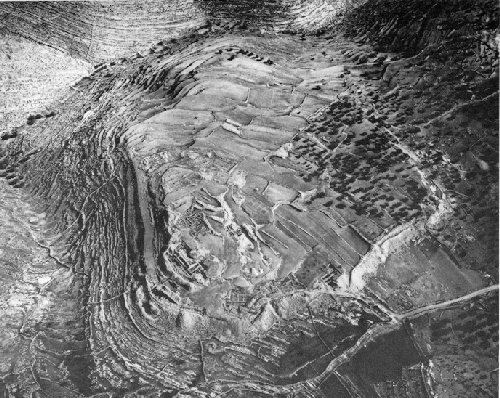|
Other Archaeological Sites / The Neolithic of the Levant (500 Page Book Online) Biblical Ai (Et Tell) ProofRead and Updated July 6th 2019 Selected Excerpt on Ai (Et Tell)
Egypt, Canaan, and Israel in Ancient Times The Oxford Encyclopedia of Archaeology in the Near East Ai is a biblical site located east of Bethel. Et Tell is generally accepted as biblical Ai; both the Hebrew and Arabic names for the site mean the ruin heap. Ai was the second place attacked by the incoming Israelites under Joshua. The major evidence from Et Tell points to five settlement phases with abundant cultural remains. The original settlement (Early Bronze IB circa 3250-3100 BC) is an unwalled village 220 metres long. The artifacts indicate a mixture of local Chalcolithic traits of the indigenous population and also foreign elements. The second settlement phase (EB IC circa 3100-2950 BC) was a well-planned city enclosing 275 acres. Massive fortifications were constructed over the homes in the unwalled village. The changes in material culture and settlement plans suggest that the indigenous population was absorbed by newcomers -- possibly from Anatolia and Syria. This settlement ended in destruction -- a blanket of ashes being mute testimony to the violent event. The settlement was rebuilt in the third major phase (EB II circa 2950-2775 BC) of its history. The inhabitants repaired and modified buildings and widened and strengthened the fortifications -- all inferior to those of the original city. The massive destruction of this city may have been caused by an earthquake accompanied by an intense fire. Egyptian involvement in the rebuilding of the fourth settlement (EB III circa 2775-2400 BC) is evident in the temple-palace and in the corner-gate area of the fortifications. This phase was ended by another violent destruction (circa 2400 BC) and the site was abandoned and left in ruins for more than a millennium. The fifth and final settlement phase (Iron I circa 1200-1050 BC) was established on the terraces of the tell (mound) by newcomers. The new villagers -- probably Proto-Israelite -- did not fortify their settlement. This settlement may have represented the early Israelite villagers described in the Book of Judges ...
Scholars had come to the conclusion largely through the influence of W.F. Albright (1924) that Joshua's Ai should be located at et-Tell, about 9 miles (15 km) north of Jerusalem. Et-Tell however does not meet the biblical requirements for Ai; the most obvious disagreement being that there was no occupation at the time of the Conquest ...
See: Researching Ai --- Article Written by Bryant Wood in The large Early Bronze Age ruin at et-Tell should be identified as the landmark site of Ai in Abraham's day (Genesis 12:8). It is east of El-Bireh (Bethel) and the modern Arabic name “et-Tell” means “the ruin” as does the Hebrew rendering of the name hā·‘āy which always includes the definite article. The name could have later migrated to the site of Khirbet el-Maqatir, which is only 1 km to the west and then, following the destruction by the Israelites, been changed to Khirbet el-Maqatir which means “the ruin of the place of the rising of sacrificial smoke”. The rising of the smoke from the signal fire set by the ambush force was the signal for Joshua to begin the haram: the offering up of the people of Ai as a sacrifice to Yahweh (Joshua 8:21-26). After Ai was plundered there was further sacrificial smoke when Joshua set fire to the fortress (Joshua 8: 27—28).
Giving the Sense: Understanding and Using Old Testament Historical Texts
Read the
Biblical Ai at Khirbet el-Maqatir Page ... |




